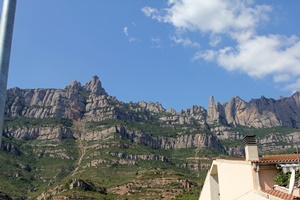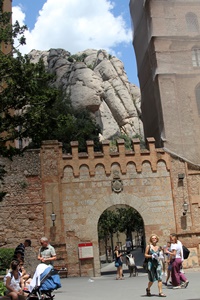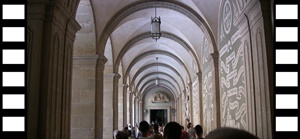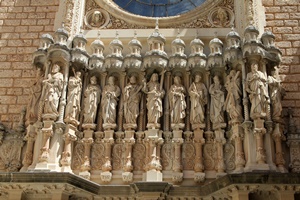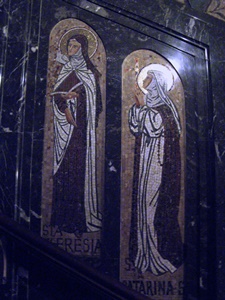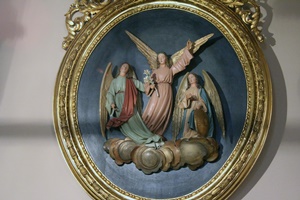Montserrat is Catalan for “serrated mountain”, the meaning of which becomes obvious with a glance at the place. Montserrat is a mountain, 30 minutes or so northwest of Barcelona, whose highest peak, at 4055 feet, is not extravagantly tall as mountain peaks go. However, it rises sharply from its surroundings, and has been eroded into many sharp, rocky peaks, making for unusually impressive scenery. And this being Spain, the unusual scenery makes for legends. One legend says the mountain was carved into its present form by angels. Geologists have a different legend, one having to do with erosion and conglomerate rocks. Feel free to pick whichever legend you prefer.
Another legend has to do with a carved wooden figure of the Virgin and Child, known as the Virgin of Montserrat. It is said this figure was originally carved by St. Luke in the first Century A.D. It somehow found its way to Spain and was hidden in a cave to protect it from the Moors. According to the legend, some shepherd children in the year 880 saw a "great light" in the area, and investigation led to the discovery of the figure. An attempt was made to carry the figure to a nearby town, but the figure is said to have become very heavy. This was taken as a sign that the figure didn’t want to leave, so they put it down and built a Benedictine monastery around it, up on the mountain. This is where the figure remains.
The Virgin of Montserrat is made of very dark wood, and is sometimes called "the Black Madonna". The darkness of the wood is apparently related to its great age. Scientists, intent on messing with perfectly good legends, have carbon-dated the figure to the 12th Century. Nevertheless, the Madonna is the object of great veneration, and people come from great distances to see it. If you were paying attention when you were looking at the pictures on the Barcelona Cathedral page, you may have noticed a picture of a side chapel devoted to the Virgin of Montserrat, featuring a copy of the original figure.
One historical item about Montserrat that is not disputed by anyone is the fact that the monastery was pretty much destroyed in the early 19th Century, during a visit by the troops of Napoleon. Nearly all the construction now seen in the area was performed in the 19th and 20th Centuries.
There are a few ways to get from Barcelona to Montserrat. We chose to take the train (one can also take a bus or drive). To visit the monastery, it’s most cost-effective to buy a package ticket, available at the tourist information booth in Plaça de Catalunya or in the train station at Plaça de Espanya (the Metro’s Espanya station). The tickets are also available online. The best package ticket includes the train trip to the vicinity of the mountain, transport up the mountain, a meal and admission to a couple of handy funiculars near the monastery. For the "transport up the mountain" part, there are two options: a cable car gondola ride (called the Aeri de Montserrat), or a ride on the Montserrat Rack Railway. We bought our tickets in the morning in the Plaça de Catalunya. At the time we bought them, they were sold out of the cable car option tickets, so we got tickets for the Rack Railway. We made our way to the train station and took our 40-minute train ride to the Montserrat area. We got off at the Monistrol de Monserrat station (there is a separate station for the Aeri de Montserrat) and found the Rack Railway to be waiting for us. We boarded the short, modern-looking train and were soon crawling up the mountainside. Eventually we were dumped out at the station near the monastery.
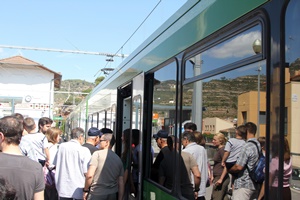
Boarding the Rack Railway Med Lrg Xlg |
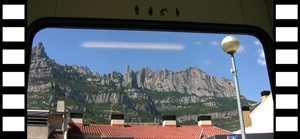
Waiting in the Rack Railway MP4-Sml MP4-Med WMV-HD |
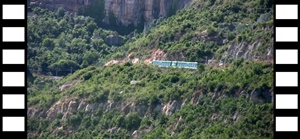
Climbing the Mountain MP4-Sml MP4-Med WMV-HD |
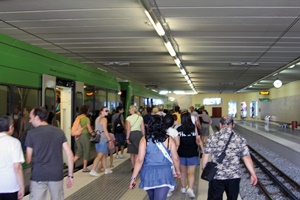
Arrival Station Med Lrg Xlg |
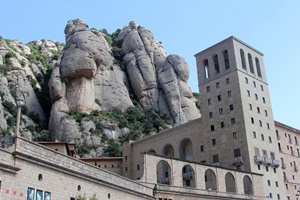
Monastery and Rocks Med Lrg Xlg |
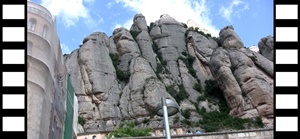
Museum, Monastery and Rocks MP4-Sml MP4-Med WMV-HD |
We made our way to a large plaza in front of the monastery, where we paused to enjoy the view.
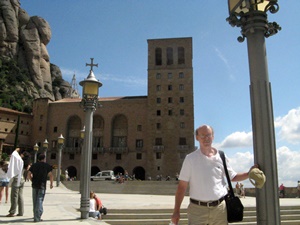
Bob and Monastery Med Lrg |
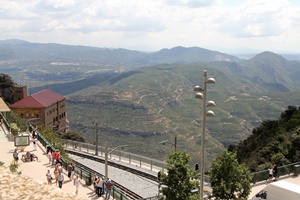
Train and Teleferic Stations with Valley Med Lrg Xlg |
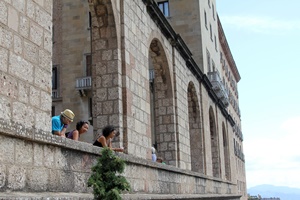
Nella Med Lrg Xlg |
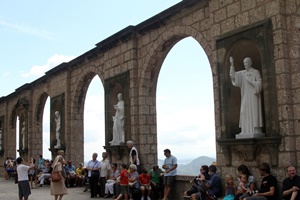
Arches and Statues Med Lrg Xlg |
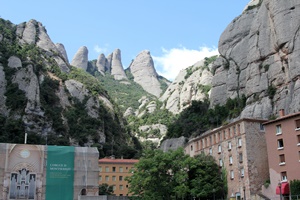
Rocks from Monastery Med Lrg Xlg |
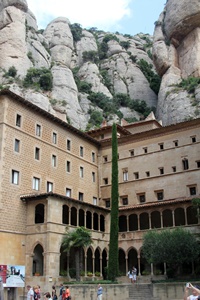
Cloister Med Lrg Xlg |
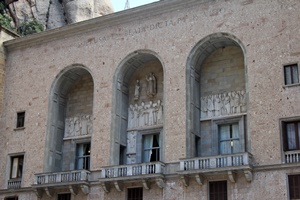
Arches Above Entrance to Sanctuary Med Lrg Xlg |
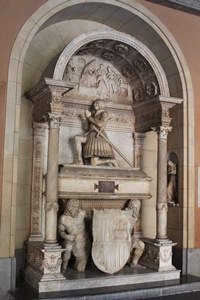
Tomb of Don Juan of Aragon Med Lrg Xlg |
We entered the atrium and found ourselves facing the monastery’s basilica, the façade of which was elaborately carved (apparently by monks, way back in the 1950’s).
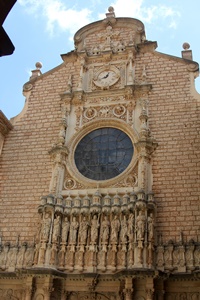
Basilica Façade Med Lrg Xlg |
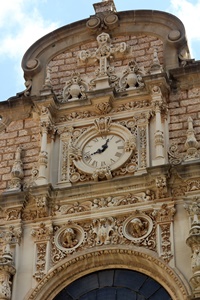
Clock, Basilica Façade Med Lrg Xlg |
We entered the basilica and found it to be beautifully decorated, though some extensive scaffolding indicated that a fair amount of work was ongoing.
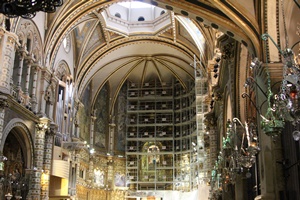
Basilica Interior Med Lrg Xlg |
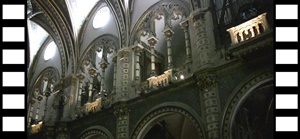
Basilica Interior, Virgin of Montserrat MP4-Sml MP4-Med WMV-HD |
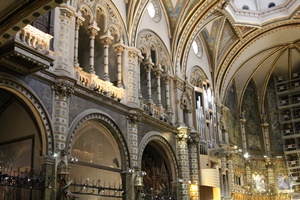
Basilica Interior Med Lrg Xlg |
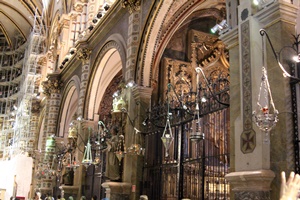
Lamps Med Lrg Xlg |
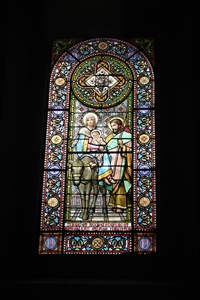
Stained Glass - Holy Family, Flight to Egypt Med Lrg Xlg |
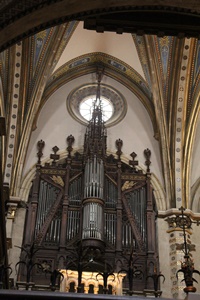
Old Organ Med Lrg Xlg |
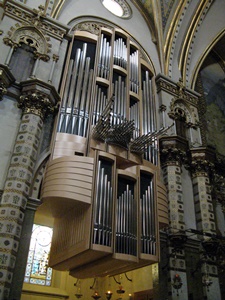
New Organ Med Lrg |
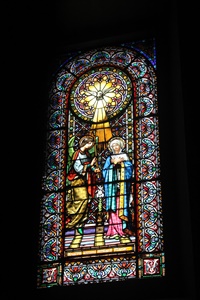
Stained Glass - Anunciation Med Lrg Xlg |
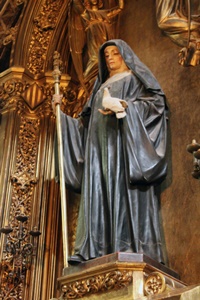
Saint with Dove Med Lrg Xlg |
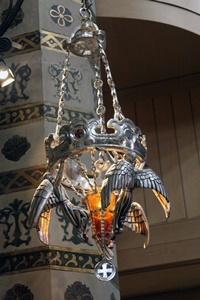
Lamp Med Lrg Xlg |
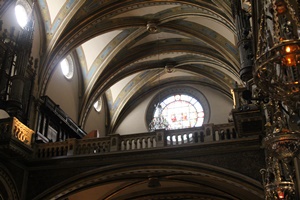
Ceiling and Choir Med Lrg Xlg |
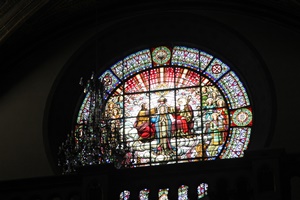
Stained Glass - Coronation of the Virgin Med Lrg Xlg |
The line wasn’t very fast-moving, but it eventually entered the church through a door to the right of the façade. The leisurely progress of the line gave us time to enjoy the chapels the line was passing through. There were chapels devoted to St. Peter, St. Martin and St. Ignatius of Loyola.
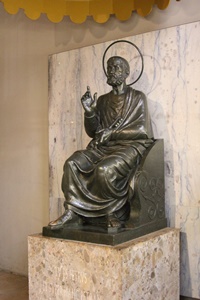
Bronze of St. Peter (Josep Viladomat, 1945) Med Lrg Xlg |
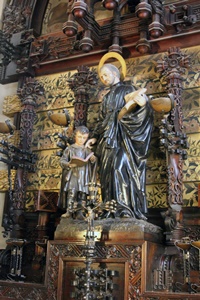
Altarpiece of St. Joseph Calasantius (1891) Med Lrg Xlg |
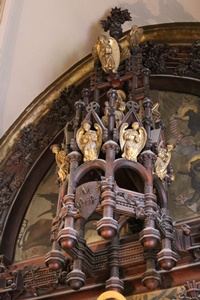
Altarpiece of St. Joseph Calasantius, detail Med Lrg Xlg |
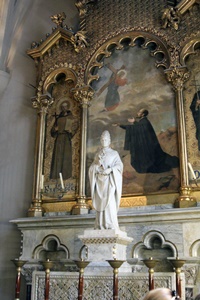
Chapel of St. Ignatius Med Lrg Xlg |
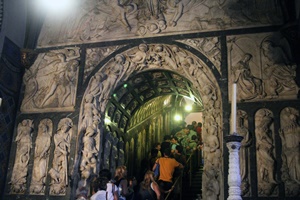
Angelic Door (Enric Monjo, 1946-54) Med Lrg Xlg |
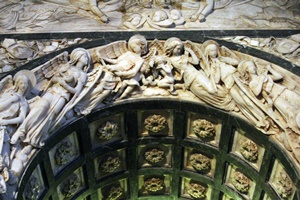
Angelic Door, detail Med Lrg Xlg |
The passageway turned left and past some more decorations.
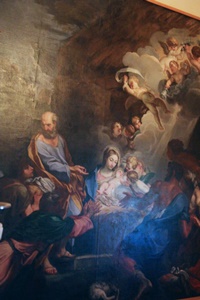
Nativity Painting (Josep Obiols) Med Lrg Xlg |
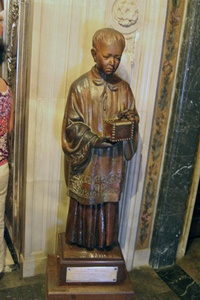
Choir Boy Donation Box Med Lrg Xlg |
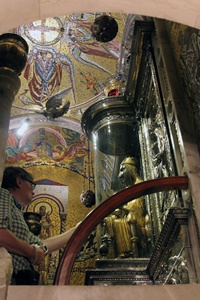
The Virgin of Montserrat Med Lrg Xlg |
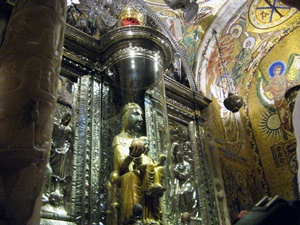
The Virgin of Montserrat Med Lrg |
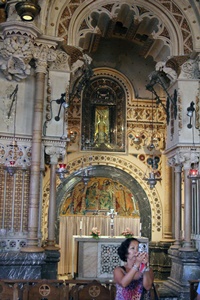
Nella and Altar Med Lrg Xlg |
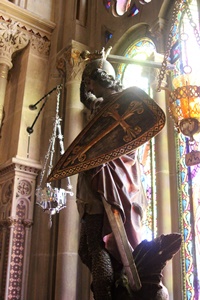
Statue of St. George Med Lrg Xlg |
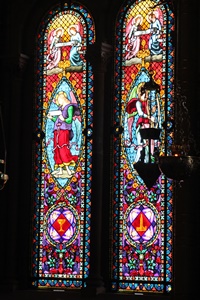
Stained Glass Med Lrg Xlg |
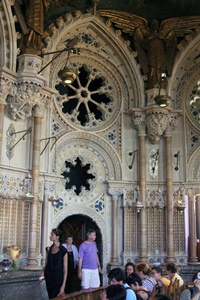
The Chapel Med Lrg Xlg |
Eventually we exited the chapel and the church, finding ourselves in an alleyway called the Cami de l’Ave Maria, which featured large racks of lit candles. Additional candles are available for purchase if you want to add to the display.
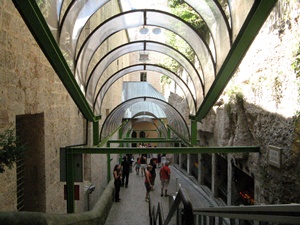
Cami de l’Ave Maria Med Lrg |
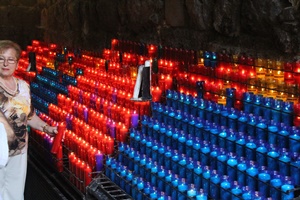
Candles, Cami de l’Ave Maria Med Lrg Xlg |
The end of the Cami de l’Ave Maria brought us back to the atrium facing the front of the church. We continued through the Sanctuary, back to the large plaza where we started. Then we started looking around to see what else Montserrat had to offer.
